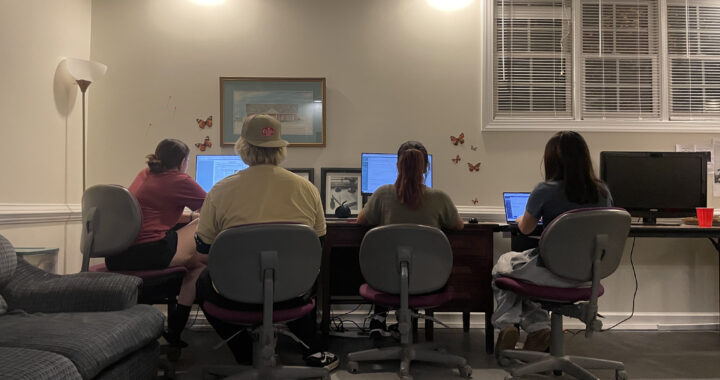Op-Ed: Animal research at UMW is not inhumane
4 min read
PSYC 413 students deny that UMW conducts inhumane research in their labs. | The Weekly Ringer
Keshana Johnson, Noah Harold, Sarah Baxter, Elizabeth Foltz, Logan Miller, & Flavia Pineda
Contributing Writers
We are students currently enrolled in PSYC 413, a senior seminar in which we investigate the behavior of living nonhuman organisms—in our case, laboratory rats. We feel we must address the recent opinion piece in The Weekly Ringer that decried “inhumane” animal research on UMW’s campus. The article to which we respond reflects an undesirable position built on ideology rather than facts. The author quotes an anonymous student who is not an expert on rats nor the functioning of laboratories; does not use a scientific source as a guide for proper living conditions but instead an independent blog called Little Grabbies; irresponsibly conflates the research of various disciplines; and cannot make the case that there are any “innovative alternatives” in studying organismal behavior.
The article leads by presenting the student’s concerns about the conditions in the University’s rat laboratory. This student states it was “obvious” that the rats were “eager to stretch and explore and were limited by the lack of room to move freely and the absence of any toys.” Such statements reflect a poor understanding of a rat’s world and blatant ignorance of laboratory guidelines. The author transitions to discussing the size of UMW’s mouse cages and cites a pet blog as an authority. First, mice and rats are different animals. Second, the rat housing in the UMW Psychological Science building is approximately 160 square inches, in which two animals—each approximately 240 grams in weight—are placed. Under these circumstances, the eighth edition of “The Guide for the Care and Use of Laboratory Animals” recommends a minimum of 29 square inches of floor space per animal—this means we could house five rats in each cage, but we house them only in pairs, so there is more than enough room for them to be comfortable. Rats are also social creatures, so it is recommended to house them together; doing so will positively affect their ability to cope with environmental stressors. Quoting an anonymous student on these matters, without any attempt to ask an expert, is disingenuous on the part of the author.
Further along, the author suggests there has been a transition from the use of animals to other alternatives. However, it is important to distinguish between pharmaceutical research, cosmetic laboratory testing and behavioral laboratory observations—lines which the author carelessly blurs. Investigating the free behavior of a rat is markedly different from injecting them with experimental drugs or performing research on cosmetics. Lambert suggests that “innovations like in vitro cell testing, computer simulations and organ-on-a-chip technologies now provide valuable data without resorting to animal exploitation.” First, experimenting is not synonymous with exploiting. Second, this statement is only true for some forms of scientific research, of which organismal behavior is not one. Behavior cannot be understood by looking at cells through a microscope, measuring tissue growth or counting colonies on a petri dish. Additionally, computer simulations and artificial intelligence as surrogates have their limitations; any such programs can be only as sophisticated as current data and are unlikely to aid researchers in discovering breakthroughs in psychological science. Furthermore, these programs can serve only as a model for research already completed by observing living organisms.
The University of Mary Washington follows ethical guidelines on what research is allowed with vertebrate animals. These guidelines are provided in the “Guide for the Care and Use of Laboratory Animals” and are in accordance with federal policy established by the U.S. Public Health Service. The University’s Institutional Care and Use Committee (IACUC) is tasked with evaluating research proposals and is required to follow the applicable laws concerning the welfare of vertebrate animals. The aims of the IACUC are labeled as the “three R’s:” that of reduction of the number of animals used; refinement of the techniques to minimize pain and distress; and replacement of animals with lower species or non-animal methods.
Twice a year UMW’s IACUC requires a veterinary visit, a review of the institution’s program and a meeting with all committee members to inspect animal facilities. There is no reason for ongoing veterinary presence on campus—i.e., “real-time oversight”—as health issues are rare and our animal facilities are small compared with large research institutions. Lambert accuses the IACUC of bias because committee members with conflicts of interest vis-à-vis the committee’s business are not allowed to vote on specific matters. The implication is that the author would rather have scientists on the committee voting on the permissibility of their own research proposals, which is clearly inappropriate.
The University of Mary Washington provides opportunities for students to gain experiences that enhance professional consideration after graduation. Psychology is a competitive field in which students with experience working with live animals may be more marketable for graduate programs. This may be especially true of students who desire to become experimentalists, and we as students are glad to have this particular learning opportunity available to us at UMW.











